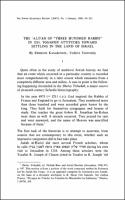Please use this identifier to cite or link to this item:
https://hdl.handle.net/20.500.12202/8564| Title: | The ’Aliyah of “Three Hundred Rabbis” in 1211: Tosafist Attitudes toward Settling in the Land of Israel |
| Authors: | Kanarfogel, Ephraim |
| Keywords: | Tosafist attitudes settling in Israel medieval Jewish history |
| Issue Date: | Jan-1986 |
| Publisher: | Philadelphia : Dropsie College for Hebrew and Cognate Learning, [1910- |
| Citation: | Kanarfogel, E. (1986). The ’Aliyah of “Three Hundred Rabbis” in 1211: Tosafist Attitudes toward Settling in the Land of Israel. The Jewish Quarterly Review, 76(3), 191–215. https://doi.org/10.2307/1454507 |
| Series/Report no.: | The Jewish Quarterly Review;76(3) |
| Abstract: | Quite often in the study of medieval Jewish history we find that an event which occurred in a particular country is recorded most comprehensively in a later source which emanates from a completely different area and milieu. A case in point is the following happening chronicled in the Shebet Yehudah, a major oeuvre of sixteenth century Sefardic historiography: ¶In the year 4971 (= 1211 C.E.), God inspired the Rabbis of France and England to go to Jerusalem. They numbered more than three hundred and were accorded great honor by the king. They built for themselves synagogues and houses of study. Our teacher the great kohen R. Jonathan ha-Kohen went there as well. A miracle occurred. They prayed for rain and were answered, and the name of Heaven was sanctified because of them.1 ¶The first task of the historian is to attempt to ascertain, from sources that are contemporary to this event, whether such an impressive emigration did in fact take place.(from Introduction) |
| Description: | Scholarly article |
| URI: | https://doi.org/10.2307/1454507 https://hdl.handle.net/20.500.12202/8564 |
| ISSN: | Print: 0021-6682 Electronic: 1553-0604 |
| Appears in Collections: | Bernard Revel Graduate School of Jewish Studies (BRGS): Faculty Publications |
Files in This Item:
| File | Description | Size | Format | |
|---|---|---|---|---|
| Ephraim_Kanarfogel_The_Aliyyah_of_Three 191-215.pdf | 2.01 MB | Adobe PDF |  View/Open |
This item is licensed under a Creative Commons License

